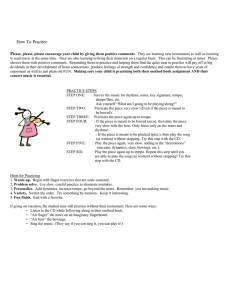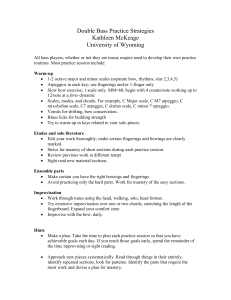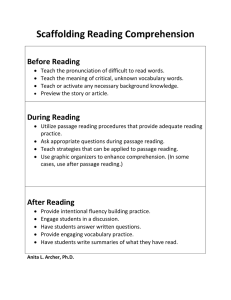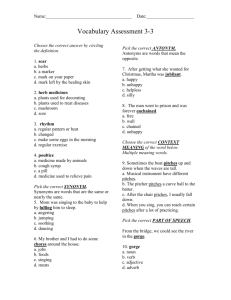Ideas on Practicing Slow is good.
advertisement
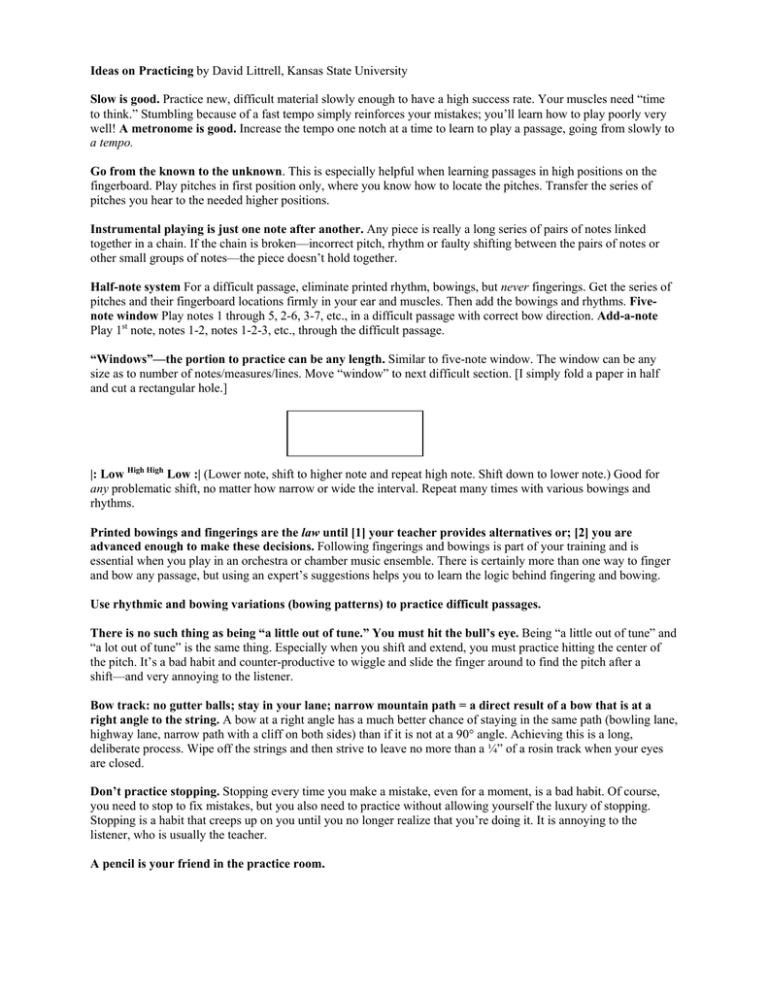
Ideas on Practicing by David Littrell, Kansas State University Slow is good. Practice new, difficult material slowly enough to have a high success rate. Your muscles need “time to think.” Stumbling because of a fast tempo simply reinforces your mistakes; you’ll learn how to play poorly very well! A metronome is good. Increase the tempo one notch at a time to learn to play a passage, going from slowly to a tempo. Go from the known to the unknown. This is especially helpful when learning passages in high positions on the fingerboard. Play pitches in first position only, where you know how to locate the pitches. Transfer the series of pitches you hear to the needed higher positions. Instrumental playing is just one note after another. Any piece is really a long series of pairs of notes linked together in a chain. If the chain is broken—incorrect pitch, rhythm or faulty shifting between the pairs of notes or other small groups of notes—the piece doesn’t hold together. Half-note system For a difficult passage, eliminate printed rhythm, bowings, but never fingerings. Get the series of pitches and their fingerboard locations firmly in your ear and muscles. Then add the bowings and rhythms. Fivenote window Play notes 1 through 5, 2-6, 3-7, etc., in a difficult passage with correct bow direction. Add-a-note Play 1st note, notes 1-2, notes 1-2-3, etc., through the difficult passage. “Windows”—the portion to practice can be any length. Similar to five-note window. The window can be any size as to number of notes/measures/lines. Move “window” to next difficult section. [I simply fold a paper in half and cut a rectangular hole.] |: Low High High Low :| (Lower note, shift to higher note and repeat high note. Shift down to lower note.) Good for any problematic shift, no matter how narrow or wide the interval. Repeat many times with various bowings and rhythms. Printed bowings and fingerings are the law until [1] your teacher provides alternatives or; [2] you are advanced enough to make these decisions. Following fingerings and bowings is part of your training and is essential when you play in an orchestra or chamber music ensemble. There is certainly more than one way to finger and bow any passage, but using an expert’s suggestions helps you to learn the logic behind fingering and bowing. Use rhythmic and bowing variations (bowing patterns) to practice difficult passages. There is no such thing as being “a little out of tune.” You must hit the bull’s eye. Being “a little out of tune” and “a lot out of tune” is the same thing. Especially when you shift and extend, you must practice hitting the center of the pitch. It’s a bad habit and counter-productive to wiggle and slide the finger around to find the pitch after a shift—and very annoying to the listener. Bow track: no gutter balls; stay in your lane; narrow mountain path = a direct result of a bow that is at a right angle to the string. A bow at a right angle has a much better chance of staying in the same path (bowling lane, highway lane, narrow path with a cliff on both sides) than if it is not at a 90° angle. Achieving this is a long, deliberate process. Wipe off the strings and then strive to leave no more than a ¼” of a rosin track when your eyes are closed. Don’t practice stopping. Stopping every time you make a mistake, even for a moment, is a bad habit. Of course, you need to stop to fix mistakes, but you also need to practice without allowing yourself the luxury of stopping. Stopping is a habit that creeps up on you until you no longer realize that you’re doing it. It is annoying to the listener, who is usually the teacher. A pencil is your friend in the practice room.
